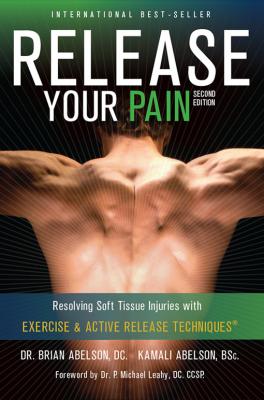ТОП просматриваемых книг сайта:
Release Your Pain: 2nd Edition - EBOOK. Dr. Brian James Abelson DC.
Читать онлайн.Название Release Your Pain: 2nd Edition - EBOOK
Год выпуска 0
isbn 9780987866219
Автор произведения Dr. Brian James Abelson DC.
Жанр Здоровье
Серия Release Your Body
Издательство Ingram
With many soft-tissue injuries, repetitive motions cause chronic irritation to soft tissue, resulting in increased friction and pressure, which eventually leads to small tears within the soft tissue. These in turn cause inflammation, decreased circulation, and edema.
Fig 2.1: Effects of Soft-Tissue Injuries on Your Body.
Types of Soft-Tissue Injuries
There are numerous types of soft-tissue injuries, with some of the most common being:
Back and Neck Injuries - Manifests as pain, inflammation, and tenderness to the nerves, tendons, muscles, and other supporting structures of the back. Back and neck injuries include whiplash injuries, disc problems, sciatica, lumbar strains, piriformis syndrome, facet syndrome, and arthritis. See Resolving Neck and Back Pain for more information.
Shoulder Injuries - Common shoulder injuries include Rotator Cuff Syndrome, Frozen Shoulder, Tendonitis, and impingement syndromes. See Resolving Shoulder Injuries for more information.
Elbow Injuries - Manifests as inflammation and pain on the inner and outer portions of the bony prominences known as the medial epicondyle and lateral epicondyle. Initially, it is the tendons that attach the muscles to these areas that become inflamed and injured. Common elbow injuries include Tennis Elbow and Golfer’s Elbow. See Resolving Elbow Injuries for more information.
Carpal Tunnel Syndrome (CTS) - Manifests as numbness and tingling of the hand, wrist pain, a pins-and-needles feeling at night, weakness in the grip, and a lack of coordination. See Resolving Carpal Tunnel Syndrome (CTS) for more information.
Knee Injuries - Common knee injuries include Runner’s Knee, Chondromalacia Patellae, ITB Syndrome, and meniscal and ligament pain. See Resolving Knee Injuries for more information.
Achilles Tendonitis - Manifests as inflammation in the tendons of the calf muscle at the point where the tendon attaches to the heel bone. Achilles Tendonitis causes pain and swelling at the back of the leg near the heel, and over the actual Achilles Tendon. See Resolving Injuries to the Achilles Tendon for more information.
Plantar Fasciitis - Manifests as inflammation, localized tenderness, or pain at the plantar fascia, a structure that stretches under the sole of the foot and attaches at the heel. See Resolving Plantar Fasciitis for more information.
All of these injuries, and many others, can be successfully and effectively treated with Active Release Techniques (ART). This book discusses many of these conditions, and describes both treatment methods and preventive measures that you can take.
Note: Ensure your Doctor first rules out any organic causes of soft-tissue injuries such as arthritis, renal failure, hypothyroidism, diabetes, high blood pressure, and hormonal imbalances. Most remaining cases of soft-tissue injuries are related to specific physical factors and can be successfully treated with ART.
The Cumulative Injury Cycle
The Cumulative Injury Cycle® is a self-perpetuating cycle that describes how acute injuries and soft-tissue injuries can become chronic problems. As we follow the cycle around, it is very easy to see how each factor leads to, or continues to perpetuate, the cycle of injury.
Fig 2.2: The Cumulative Injury Cycle® was formulated, tested, published, and copyrighted by Dr. P. Michael Leahy - developer of Active Release Techniques®.
The Law of Repetitive Motion
(Copyright: Dr. P. Michael Leahy, DC, CCSP)
Dr. Michael Leahy has defined and tested the Law of Repetitive Motion® to describe the physical factors involved in a Repetitive Strain Injury. The Law of Repetitive Motion provides a way to predict the possibility of RSI, and also points to possible solutions for addressing RSI problems by altering the key variables.
Applying the Law of Repetitive Motion
All the above factors must be addressed in order to completely resolve problems caused by repetitive actions. Most of these factors are under your control.
ART can very effectively increase your relaxation time (factor R) by removing the constant pressure and tension that results from the formation of adhesions or scar tissue.
Muscles that are restricted, tight, and adhesed cannot relax. By releasing these restrictions, ART can help you to achieve better muscle function, and prevent the return or reoccurrence of the repetitive strain injury.
Fig 2.3: Applying the Law of Repetitive Motion.
For more information about how the Law of Repetitive Motion applies to your injuries, read Applying the Law of Repetitive Motion to CTS.
_______________________
1. Hypoxia-induced VEGF and collagen I expressions are associated with angiogenesis and fibrogenesis in experimental cirrhosis, Christopher Corpechot, Veronique Barbu, Dominique Wendum, Nils Kinnman, Colette Rey, Raoul Poupon, Chantal Housset, Olivier Rosmorduc, Hepatology, Vol 35, No. 5, 2002.
Why is RSI a Problem?
Chapter
3
What is a Repetitive Strain Injury?
What Causes a Repetitive Strain Injury?
What is the Economic Impact of RSI?
Finding a Viable Solution for RSI
Repetitive Strain Injuries (RSI) have become a major drain on our health care system. Loss of productivity caused by employees working while in pain cost companies over $61.2 Billion each year.
(Journal of the American Medical Association 2003)
Repetitive Strain Injury (RSI) is caused by repeated physical movements that cause ongoing

